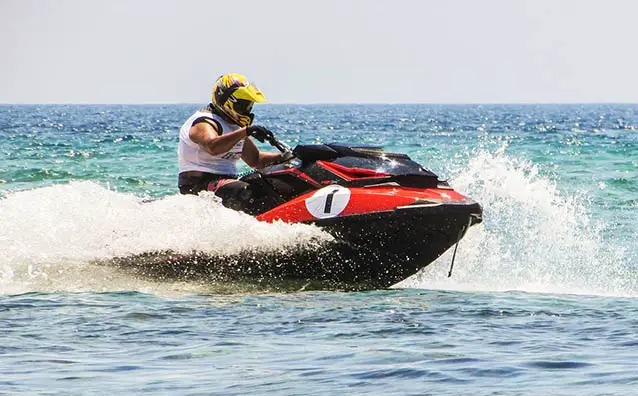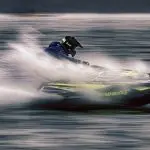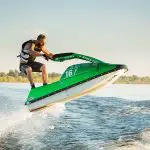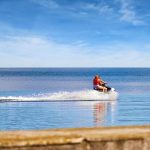Personal watercraft fairly exploded as an outdoor activity in the 1990s, with thousands of new riders taking up the sport.
Which in some ways makes it curious that it wasn’t until the turn of the century that PWC manufacturers considered adding some form of low-speed steering to the handling equation.
As you doubtless know, personal watercraft go where the jet pump points them. The rider, in turn, points the jet pump with the handlebars. This only works, however, with the application of throttle. Off the throttle, the boat is just drifting – or continuing in the direction it was going.
This was and is somewhat counter-intuitive to new riders. Most people first operate motor vehicles on land, and letting off the throttle in uncertain or changing situations becomes instinctual for most.
And yet, it’s exactly the wrong thing to do when riding personal watercraft.
Contents
The ill-fated OPAS system
Recognizing that less experienced operators could be caught off guard by needing to accelerate – at least slightly – in order for the machine not to drift or far worse, careen into an immovable object like a dock or another boat, Sea-Doo attempted to address the issue with a system it dubbed OPAS. That’s Off Power Assisted Steering.
How does Sea-Doo O.P.A.S work?
How did it work?
Well… not that well, in the end. In certain riding conditions, it was as much a detriment as it was an aid at lower speeds.
Sea-Doo added two fins, mounted at the rear on either side of the hull, that worked as mechanical rudders to allow off-throttle steering.
And there lied the rub.
The intent was to allow a rider to regain control when off throttle, but how did the boat know? By utilizing a sensor in the jet pump. As designed, the rudders remained inactive when the pump was pressurized with water and would only deploy when low pressure was detected.
Cables activated by handlebar movement sent either rudder into action, pushing out from the side of the hull to allow for steering.
And this was fine. Except that it ignores that in rougher water, choppy conditions, or riding aggressively, a rider might quite often cut the throttle for any number of reasons – for instance, when the pump might cavitate due to the pump being bounced out of the water by a big wave.
It’s not good for the pump, housing, impeller, or impeller bearing to go from freewheeling at high RPM in the open air to being immediately loaded again upon splashdown. More experienced riders knew to chop the throttle momentarily, then reapply at the pump set back down.
And then, as it turned out, some of those more experienced riders got bucked right off when rudders designed for low-speed operation were suddenly sticking out at 60 mph!
The OPAS system and IBR
The OPAS system debuted with the all-new 2002 Sea-Doo GTX 4-Tec model, the first four-stroke the company had offered. It was an innovative machine in many ways, most of which have stuck around.
But, after equipping all its 3-seater model line – the RXT, the RXT-X, the aforementioned GTX, and the Wake series – for the next seven years, the company would abandon the OPAS. A similar but more successful strategy dubbed “iBR” – standing for Intelligent Brake and Reverse System – was employed thereafter and to this day.
Pulling the Plug
Why some of you are removing OPAS?
Again, with OPAS, choppy waters would continually vary water pressure to the pump. This would lead to irregular activation of the outboard rudders.
Sometimes you’d slap back down in the water and pin the throttle only to have the boat shoot in either direction suddenly due to a deployed rudder at speed. This would, on occasion, lead to fairly violent highsides – i.e. going over the high side of the handlebars, ass over the elbow, and feet flailing in the air.
Not pleasant. And not confidence inspiring.
After even one such experience, many if not most began to look for a way to remove the system altogether.
This involved eliminating the whole apparatus, and of course, blocking off the holes left behind in the hull. With a couple of plates of aluminum and some silicone, this could be accomplished under the shade tree.
OPAS removal
As memory serves – it’s been a few years – the hugely popular Riva aftermarket supplier was the first to offer a kit that eliminated both the OPAS system and the need for fabrication skills.
A quick check on the ole’ interwebs reveals that the Riva kit is still available. It includes block-off plates, plugs, O-rings, and of course instructions for installation for just over a hundred bucks.
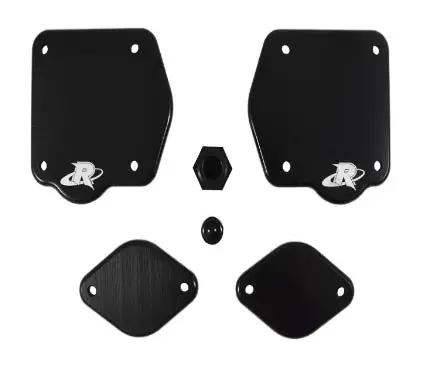
Riva has long been a stalwart in quality aftermarket parts, and I can unreservedly recommend the company as a supplier.
Full disclosure, I haven’t seen or talked to Riva owner Dave Bamdas in over a decade. I can however tell you that he took his mom and pop’s dealership – literally, Dave’s parents Steve and Lynn Badas first opened a small motorsports dealership in Pompano Beach, Florida in 1979 to sell Lambretta motor scooters – and turned it into a hugely successful Yamaha dealership. After acquiring the rights to sell Yamaha Riva scooters, thus the name, Dave and his family jumped into the PWC field as the Waverunners were first introduced. They would win multiple world championships at Lake Havasu while also developing an extensive product line for all brands of PWCs.
Through all this, Dave remained the same approachable down to earth guy. He even helped me carry beer kegs into a house Watercraft World had rented for the Lake Havasu World Finals one year, despite being one of the magazine’s biggest advertisers. I seem to remember that we forfeited the security deposit that week after Jason Stoyer put on an impromptu freestyle demo with stand-up in the swimming pool. But I digress. Point is, that Riva is core.
Note that the kit is marked “for competition use only.” That’s a bit overblown, but it’s understandable that any company would be leery of the liability of selling a kit that alters the handling of a stock unit.
And yes, in the unlikely event you have a Sea-Doo that still has the OPAS system, removing it will cause you to lose off-throttle steering. If you’ve just taken up the sport, perhaps take the time to learn to use short bursts of throttle to steer just like we did back in the day.
Conversely, removing the system definitely makes the boat more stable at speed with no risk of unwanted deployment in choppy waters.
Sea-Doo OPAS Competition Kit
The above kit I’ve used myself. Riva would later come out with another fix, and I’ve no personal experience with the rather oddly named Sea-Doo OPAS Competition Kit.
But it looks like it would work well, eliminating the unpredictability of OPAS deployment with “precision-machined composite collars” designed to prevent the OPAS fins from dropping when the pump cavitates or is out of the water. According to the Riva website, these collars install “quickly and easily without tools.”
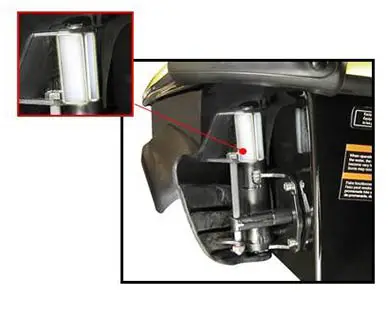
Again, I’ve not tried it. But I do have every confidence in the Riva product line. And at a paltry $21.95 it seems like an even better solution, retaining the benefit of the OPAS system while eliminating the major problem. That’s a win-win!
Still, were it me, I’d go the block-off plate route. In addition to the handling issues, to me, it’s an unnecessary system that is somewhat prone to failure and breakage that creates additional drag on the hull at speed.
Other solutions
As a final note, there are other aftermarket solutions. Pretty sure it’s already clear that I’m partial to Riva, but looking around a bit I found the below block-off kit selling for just $25.99 at JSP Manufacturing consisting of four stainless steel plates and four gaskets.
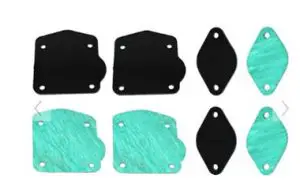
If you have a 2002-2009 Sea-Doo 3-seater, and have experienced no problems with your OPAS system, consider yourself lucky. And if you don’t find yourself riding in choppy waters, there might be no reason to consider removing it.
On the other hand, there are a plethora of block-off kits also available on Amazon, or even eBay – attesting to the popularity of removing the system altogether.
